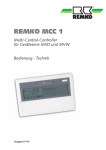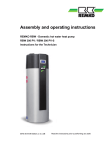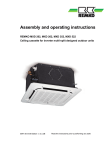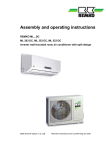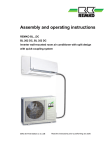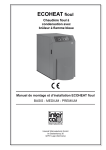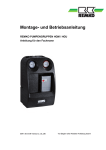Download Whirlpool EDP/EDN Technical data
Transcript
REMKO SLE 40-80 Swimming pool dehumidifier Operation · Technology · Spare parts Edition GB – T03 Contents Dehumidification 4-6 Safety information 6 Unit description 7 Installation 8 Commissioning 9 Care and maintenance 10 Troubleshooting 11 Refrigeration circuit 12 Electrical wiring diagram SLE 40-80 13 Diagram of unit SLE 40-80 14 Spare parts list SLE 40-80 15 Intended use 16 Customer service and warranty 16 Environmental protection and recycling 16 EC declaration of conformity 17 Maintenance log 18 Technical data 19 These operating instructions must be read carefully before commissioning/using the unit! Made by REMKO These instructions are part of the unit and must always be kept near to the site of installation or on the unit. Subject to changes; errors and typographical errors excepted! 3 REMKO SLE 40-80 The interrelated processes occurring during dehumidification are based on physical laws. These are illustrated here in simplified form in order to explain the principle of dehumidification. corrosion rate Dehumidification In terms of energy consumption, dehumidification has one decisive advantage: Energy expenditure is restricted solely to the existing room volume. The mechanical heat released through the dehumidification process is returned to the room. The use of REMKO dehumidifiers –No matter how well windows and doors are insulated, damp and moisture can penetrate even through thick concrete walls. –The water volumes required for binding concrete, mortar, plaster, etc. are diffused out initially after 1-2 months under certain circumstances. –Even moisture that has penetrated masonry following high water or flooding is only released very slowly. –This applies similarly to e.g. moisture contained in stored materials. The moisture (water vapour) escaping from buildings or materials is absorbed by the ambient air. This increases their moisture content and ultimately results in corrosion, mould, rot, peeling of paint coatings and other unwanted moisture damage. The diagram opposite shows an example of the rate of corrosion, e.g. for metal at different humidity levels. 4 With correct use, the dehumidifier consumes only about 25% of the energy required for the “heating and ventilation” principle. relative humidity Relative humidity It can be seen that the rate of corrosion is insignificant below 50% relative humidity and can be disregarded below 40% relative humidity. The rate of corrosion increases noticeably from 60% relative humidity. This moisture damage limit applies also to numerous other materials, e.g. powders, packaging, wood or electronic units. Buildings can be dried out in different ways: 1.By heating and air exchange: The room air is heated to absorb moisture in order to then be discharged to the atmosphere. The total input energy is lost with the discharged, moist air. 2.By dehumidification: The moist air in an enclosed room is continuously dehumidified according to the condensation principle. Ambient air is a gas mixture and always contains a certain amount of water in the form of water vapour. This water volume is expressed in g per kg dry air (absolute water content). 1m3 air weighs about 1.2 kg at 20°C Depending on the temperature, each kg of air is only able to absorb a certain amount of water vapour. When this absorptive capacity is reached, reference is made to “saturated” air; this has a relative humidity of 100%. Relative humidity is therefore understood to be the ratio between the amount of water vapour currently contained in the air and the maximum water vapour volume at the same temperature. The ability of air to absorb water vapour increases with increasing temperature. This means that the maximum (= absolute) water content increases with increasing temperature. Water vapour content in g/m3 at a humidity of Temp. °C 40% 60% 80% 100% -5 1.3 1.9 2.6 3.3 +10 3.8 5.6 7.5 9.4 +15 5.1 7.7 10.2 12.8 +20 6.9 10.4 13.8 17.3 +25 9.2 13.8 18.4 23.0 +30 12.9 18.2 24.3 30.3 Drying materials Building materials or structures can absorb substantial amounts of water, e.g. bricks 90-190 l/m³, heavy concrete 140-190 l/m³, lime-sand bricks 180-270 l/m³. The drying out of moist materials, e.g. masonry, takes place as follows: ■The air enriched with water vapour continuously circulates through the REMKO dehumidifier. It is dehumidified and leaves the unit at a slightly higher temperature to absorb water vapour from anew. ■In this way, the moisture contained in the material is gradually reduced. The material dries! ■ T he contained moisture moves from the inside of the material to its surface. The produced condensate is collected in the unit and discharged. ■Evaporation takes place on the surface = transition as water vapour to the ambient air. Condensation of water vapour Since the maximum water vapour volume increases when the air is heated, the contained water vapour volume remains the same however, this results in a reduction of the relative humidity. In contrast, when the air is cooled, the capacity to absorb the maximum water vapour volume reduces, the water vapour volume contained in the air remains the same and the relative humidity increases. If the temperature falls further, the capacity to absorb the maximum water vapour volume is reduced until it is equal to the contained water vapour volume. This temperature is called dewpoint temperature. When the air is cooled below the dew-point temperature, the contained water vapour volume is larger than the maximum water vapour volume. Water vapour is discharged. This condenses to water. The air is relieved of moisture. Examples of condensing are misted windows in winter or misting of a cold drinks bottle. The air flow is cooled on its way through or via the evaporator to below the dew point. The water vapour condenses and is collected in a condensate trap and discharged. °C % r.F. 30 100 Evaporator Verdampfer Condenser Kondensator + Air Lufttemperatur temperature 90 25 80 70 Air flow direction Luftrichtung The higher the relative humidity, the higher the dew-point temperature, which is easier to fall below. 60 20 50 40 15 30 - + Air Luftfeuchte humidity 20 10 Trend Verlauf 5 REMKO SLE 40-80 Heat of condensation The energy transferred from the condenser to the air is composed of: Vice versa, energy is released during the liquefaction of gas, which is termed heat of condensation. 1.Heat energy previously removed in the evaporator. The amount of heat of evaporation and condensation is the same. For water, this is: 2250 kJ/kg (4.18 kJ = 1kcal) 2.Electrical motive energy. 3.Heat of condensation released during condensation of the water vapour. For the change from a liquid to a gaseous state, energy is necessary. This energy is termed heat of evaporation. It does not cause any rise of temperature, it is only necessary for the change from a liquid to a gaseous state. This shows that a relatively large amount of energy is released through the condensation of water vapour. If the moisture to be condensed is not introduced through evaporation in the room itself, but from outside, e.g. via ventilation, the heat of condensation released in the process contributes towards room heating. During dehumidification, the heat energy is recircu- lated, which is consumed during evaporation and released during condensation. During dehumidification of the supplied air, a large amount of heat energy is produced, which is expressed in a rise of temperature. The time necessary for drying normally does not depend only on the unit capacity, but is rather determined by the rate at which the material or parts of the building release their moisture. Safety information The units were subjected to extensive material, functional and quality inspections and tests prior to delivery. However, the units may constitute a hazard if used by untrained personnel, improperly or not for the intended purpose. ■ The air openings must always be kept free. ■ The air suction grilles must always be kept free of dirt and loose objects. ■ The units must not be covered during operation. The following information must be observed: ■ Never insert foreign objects into the units. ■ The units must not be installed and operated in hazardous locations. ■ All electrical cables outside the units must be protected against damage (e.g. animals, etc.). ■ The units must only be installed or mounted in the intended position (horizontal). ■ Free and frost protected condensate discharge must always be ensured. ■ The unit connections must always comply with the respectively applicable installation regulations. ATTENTION ■ The units must not be installed and operated in atmospheres containing oil, sulphur or salt. ■ The units must not be exposed to direct water jets. 6 The units must be installed and mounted so that they are easily accessible for monitoring, repair and maintenance. Unit description The units are designed for universal and problem-free dehumidification. They can be installed at numerous locations due to their compact size. The units operate on the condensation principle with hermetically sealed refrigeration system with silent and low maintenance recirculation fan(s). The fully automatic electronic control, integrated hygrostat and connections for local condensate discharge ensure trouble-free, continuous operation. The units are reliable and easy to use and comply with the fundamental health and safety requirements of the pertinent EU regulations. The units are used wherever dry rooms are a necessity and damage (e.g. due to mould) is to be avoided. The units are also used for dehumidification of: Operation All units are switched on and off by the integrated hygrostat. The respective unit function is shown on the front display. The recirculation fan sucks in the humid room air via suction open����� ings below the front panel. Depending on the room air temperature and relative humidity or only during the defrost phase the condensed water constantly drips into the condensate trap and subsequently via the integrated drain connection into the condensate drain to be provided locally. This is transported via a filter, evaporator and condenser. At the cold evaporator, heat is extracted from the room air and cooled to below the dew point. The water vapour contained in the room air deposits as condensate or frost on the evaporator gills. Safety circuit: If the temperature at ��������������� the condenser should exceed 55°C (e.g. due to fan failure or clogged suction filter), the compressor au���������� tomatically stops to avoid being overloaded. The compressor restart����������� s automatically after 45 minutes. At the condenser (heat exchanger), the cooled and dehumidified air is reheated and blown back into the room via the upper blow out openings with a slight rise of temperature of about 5°C above room temperature. The conditioned drier air continuously mixes with the room air. Due to the constant circulation of the room air through the unit, the relative humidity in the room is gradually reduced to the required humidity (% relative humidity). The compressor always starts with a 30 second delay. ■Private swimming pools ■Wellness spas The hygrostat is set at the factory to 60% relative humidity. ■Whirlpool areas Functional diagram of SLE 40-80 dehumidifier ■Sports studios Heat and dehumidified air ■Store rooms/archives ■ Museums Humid room air 7 REMKO SLE 40-80 Installation For optimal and reliable unit operation, the following information must be observed in any event: ■The unit must be mounted or installed in a suitable location appropriate to the structural conditions. ■The supplied wall bracket with suitable fixing material (not included) must be fixed securely to the wall. Access to control Condensate drain After removing 2 screws at the top of the unit, lift up the front panel and remove it from the unit horizontally. The control is located in a housing above the compressor. Access to the control takes place by removing the 2 screws on the front of the housing. The condensate drain is located at the bottom of the unit. The condensate drain must be connected to the supplied drain connection. A solid or flexible ½“ drain connection can be connected. Wall mounting of units ■The unit must be mounted or installed horizontally to ensure free condensate drainage. ■Alternatively, a condensate pump (accessory) can also be mounted on the unit in order to pump the produced condensate to an outlet. ■The unit must be mounted or installed so that the air is able to be sucked in and blown out unhindered. ■For an outlet through the wall, specific preparations are necessary for correct condensate drainage prior to installation of the unit, e.g. the drilling of holes. ■For optimal operation of the unit, the minimum clearances from the unit to the ceiling and floor must be maintained. ■The unit should not be installed close to radiators or other heat sources. ■The room to be dehumidified must be closed from the ambient atmosphere. ■The drain hose must always be installed with a minimum gradient of 2% to enable the water to drain unhindered from the drip tray. ■The position of the outlet connection is shown in the diagram below. Positioning the condensate drain ■Open windows, doors, etc., as well as frequent entering and leaving the room should be avoided as far as possible. ■For optimal room air circulation by the dehumidifier, the supply and exhaust air openings must always be kept free of dirt and other obstacles. 105 318 ATTENTION Careful and professional installation must be ensured. 8 ATTENTION The unit connections must always comply with the respectively applicable installation regulations. Commissioning Prior to each commissioning or as required, the air inlet and outlet grilles must be checked for clogging. The units operate via an integrated hygrostat set to 60% relative humidity (standard value for swimming baths and indoor swimming pools). The unit does not start at room air conditions below 60% relative humidity. If the relative humidity is above 60%, the unit automatically starts the dehumidification process. The front housing panel can be removed to make any changes to the hygrostat setting. The hygrostat is located next to the evaporator below the compressor housing. Turning the control knob clockwise reduces the humidity, turning anticlockwise increases the humidity. An external hygrostat (accessory) can be fitted if required. Connection option, see under “Electrical wiring diagram”. In order to prevent compressor damage, the units are provided with reclosing protection, which prevents immediate reconnection of the compressor after disconnection The compressor initially switches on again after a delay of about 30 seconds! Note Interruption of unit operation for less than 6 minutes compressor operating time will force a restart lockout of about 4 minutes. LED display The units are provided with an electronic control. The following functions are controlled, monitored and displayed: ■Safety ■Monitoring ■On/off The LED display is located on the side of the unit. Note If the unit is switched on or off via a main switch, all LEDs successively show green and the triangle red. + + A constant „green“ lightning symbol indicates that the supply is connected to the unit. Alternating „green“ and „red“ flashing LEDs indicate a unit fault registered via the condenser sensor (overheating). If the condenser sensor registers an excessive temperature, the compressor is switched off and the unit remains inoperational for 45 minutes. After lapse of this time, the unit is automatically switched on again. After switching on again, the „red“ triangle symbol no longer flashes, the drop symbol continues to flash. The lightning symbol shows constant „green“. Symbol legend The LED shows constant „green“ when the unit is connected to the supply. The LED shows constant „green“ when the compressor is operating and the unit is dehumidifying. This LED has no function for dehumidification. + A „green“ flashing drop symbol and a constant „green“ lightning symbol indicate that the unit is functioning, but has been switched off by the condenser se����������� nsor (overheating). Note If the relative humidity is below 60%, the unit will not start, even when the supply is connected. Note The flashing drop symbol is extinguished when the power is switched off and on again. 9 REMKO SLE 40-80 Care and maintenance Fan control When the hygrostat starts the dehumidifier, the fan(s) is/are switched on together with the compressor. If constant ventilation is required, i.e. independent of dehumidification, a jumper can be connected between terminals 25 and 26. The fan or fans then operate in a continuous mode! Note Regular care and maintenance is a basic precondition for a long useful life and troublefree operation of the unit. All moving parts are provided with low-maintenance permanent lubrication. The refrigeration system is a hermetically sealed system and must only be repaired by authorised specialist companies. Defrosting At room temperatures below 20°C, the evaporator will start to frost after a short time. When the evaporator sensor registers a temperature below 5°C on the evaporator surface, the unit continues to operate for 30 minutes in dehumidification mode. After lapse of this time, the compressor stops and passive defrosting starts in that the fan or fans slowly blow room air over the evaporator and gradually defrost the same in the process. When the evaporator sensor registers a temperature above 5°C, the compressor is switched on again. Safety circuit If the temperature at the condenser should exceed 55°C (e.g. due to fan failure or excessive room temperature (above 36°C), the compressor automatically stops to avoid being overloaded. The compressor restarts automatically after 45 minutes. The drop symbol in the display flashes! 10 ■Observe regular care and maintenance intervals. ■Depending on the particular operating conditions, the units should be tested by an expert for reliable operation as necessary, but at least once a year. ■Keep the unit free of dust and other deposits. ■If the unit should become fouled, it can be cleaned with a vacuum cleaner, whereby the condenser should be thoroughly cleaned. ■If the evaporator gills are heavily fouled, they should be cleaned carefully with soapy water. Cleaning the suction filter The suction filter should be checked at regular intervals and cleaned if necessary. The filter is fixed in a holder behind the suction openings. ATTENTION Regularly check the suction and blow out openings as well as filters for clogging. ■A lightly clogged filter can be cleaned by carefully blowing out or using suction. ■A heavily clogged filter can be washed in a luke warm (maximum 40°C) soap solution. Subsequently rinse thoroughly with clear water and allow to dry! ■It must be ensured that the dust filter is completely dry and undamaged prior to refitting. ■The units must only be operated with the dust filter fitted. Note Heavily clogged dust filters must be replaced with new ones. Only original spare parts must be used. ■Do not use a direct water jet e.g. high pressure cleaner, etc. Cleaning the condensate water collecting tray ■Do not use caustic cleaning agents or those containing solvents. To ensure that the produced condensate water is able to drain freely, the condensate collecting tray and the outlet must be cleaned at regular intervals. ■Only use suitable cleaning agents to remove heavy fouling. Troubleshooting Fault •The unit does not start. Possible cause No supply voltage. • Indicates that the unit is operating, but has switched off due to overheating. Room humidity too low. • C heck the integrated or external hygrostat by setting it to a low relative humidity, e.g. < 40%. If the unit does not switch on again, the integrated or external hygrostat must be checked for a fault. The unit is outside its operating limits of 10 – 36°C. • C heck the room conditions and change if necessary. The compressor was automatically switched off due to excessive temperature. If the unit does not start after 45 minutes, the following must be checked: • Check that the fan/fans is/are operating. • Check whether the suction filter is clogged. • Check that the suction and blow out openings are free. • Check whether the condenser gills are fouled. • Check whether the room temperature is possibly above 36°C. If the room temperature is above 36°C, the unit must be switched off. •Lightning symbol in display does not light. •The unit does not start. •Lightning symbol in display shows constant „green“. •The compressor does not start. •The triangle symbol in the display flashes constant „red“. Lack of ventilation. Excessive ambient temperature. Clogged filter/suction. •The lightning symbol in the Indicates that the unit is operatdisplay shows constant „green“. ing, but has switched off due to overheating. •The drop symbol in the display flashes constant „green“. Note If no result is achieved after carrying out all functional checks, an authorised service station should be contacted. Remedy ATTENTION All work on the refrigeration system and electrical equipment must be referred to an authorised specialist! • T he indication can be cancelled by disconnecting and reconnecting the supply. ATTENTION Prior to carrying out maintenance or repairs, the unit must always be disconnected from the supply. 11 REMKO SLE 40-80 Refrigeration circuit SLE 40 7 1 3 5 Legend: 1.Compressor 2.Evaporator 3.Condenser 4.Thermal expansion valve 5.Dry filter 6.Solenoid valve 7.Fan 6 2 4 SLE 60 and SLE 80 7 8 1 3 5 2 6 4 Legend: 1.Compressor 2.Evaporator 3.Condenser 4.Thermal expansion valve 5.Dry filter 6.Solenoid valve 7.Fan 8.Non-return valve We reserve the right to make dimensional and design changes in the interest of technical advances. 12 Electrical wiring diagram SLE 40 - SLE 80 Electronic control board AMB. NTC COND. NTC R3.1 EVAP. NTC PRES. THA WAT. SENS R3.2 HYG TH. STAT Test FAN HYG = M 1 = M 2 = M 3 = M 4 = Y 1 = R3.1 = R3.2 = Hygrostat Compressor Fan motor 1 Fan motor 2 Fan motor 3 Solenoid valve Condenser sensor Evaporator sensor COMPR. VALVE HEAT FAN HYG M 1~ L1 N 230V 50 Hz Fan motors: SLE 40 = Motor M2 SLE 60 = Motor M2 and M3 SLE 80 = Motor M2, M3 and M4 Legend: MAINS Y1 M 1~ M2 M 1~ M 1~ M3 M4 M1 Constant ventilation: External hygrostat: If constant air circulation is required, i.e. independent of dehumidification, a jumper can be connected between terminals 25 and 26. Recommended for frequent humidity variation is the installation of an external hygrostat which is available as an accessory. The fan or fans then operate without any control and monitoring in a continuous mode. Disconnect the integrated hygro������ stat at terminals 21 and 22. Install the external hygrostat at a suitable location in the room to be dehumidified and connect to terminals 21 and 22. The output voltage on terminals 21 and 22 is 12V. ATTENTION Prior to carrying out maintenance or repairs, the unit must always be disconnected from the supply. Note A disconnector switch should be installed in the supply connection at a suitable and easily accessible location. Note Only authorised specialists may install and carry out maintenance work on the units! We reserve the right to make dimensional and design changes in the interest of technical advances. 13 REMKO SLE 40-80 Diagram of unit SLE 40 - 80 4 1 7 2 6 5 3 8 30 9 25 11 24 20 22 35 27 28 18 15 16 38 Fig. REMKO SLE 80 12 We reserve the right to make dimensional and design changes in the interest of technical advances. 14 Spare parts list No. Designation SLE 40 SLE 60 SLE 80 EDP No. EDP No. EDP No. 1 Wall bracket 1109144 1109165 1109177 2 Housing rear 1109145 1109166 1109178 3 Cable gland 1109129 1109129 1109129 4 Condenser 1109146 1109167 1109179 5 Fan complete with 800mm cable 1109147 1109147 1109147 6 Fan complete with 1200mm cable —— 1109168 1109168 7 Fan complete with 1600mm cable —— —— 1109180 8 Evaporator 1109148 1109169 1109181 9 Condensate tray, complete 1109149 1109170 1109182 11 Suction filter 1109150 1109171 1109183 12 Front panel 1109151 1109172 1109184 15 Evaporator sensor (metal) 1109160 1109160 1109111 16 Condenser sensor 1109161 1109161 1109161 18 Thermo valve 1109158 1109173 1109185 20 Hygrostat 1109115 1109115 1109115 22 Dry filter 1109157 1109157 1109157 24 Control board 1109152 1109152 1109152 25 Diode board with cable 1109154 1109154 1109154 27 Terminal, two-pole 1109155 1109155 1109155 28 Capacitor 1109156 1109156 1109156 30 Solenoid valve, complete 1109110 1109110 1109110 35 Non-return valve —— 1109176 1109176 38 Compressor, complete 1109162 1109174 1109186 When ordering spare parts, please always also quote the serial number (see rating plate) in addition to the EDP No.! 15 REMKO SLE 40-80 Intended use Customer service and warranty The units are designed and equipped for dehumidification purposes. A precondition for any warranty claims is that the dealer or his customer has completed and returned the enclosed “Warranty Document” to REMKO GmbH & Co. KG at the time of sale and commissioning of the units. The manufacturer is not liable for any damage attributed to failure to observe the manufacturer‘s instructions or applicable statutory requirements or unauthorised changes to the unit. Note Use for any other purpose than that described in these operating instructions is not permitted. Failure to observe this rule will invalidate all liability and warranty. The units have been repeatedly tested for perfect functioning. If malfunctions should occur that cannot be remedied by troubleshooting, your specialised dealer or contract partner should be contacted. Note Only authorised specialists may carry out adjustments and maintenance. Environmental protection and recycling Disposal of packaging Think of the environment when disposing of the packaging material. Our units are carefully packed for transport and delivered in sturdy cardboard packaging on a wooden pallet, if necessary. The packaging materials are environmentally-friendly and can be recycled. By reusing packaging material, you make a valuable contribution towards waste reduction and the conservation of raw materials. Only dispose of packaging material at the facilities provided. Disposal of old unit Attention Copyright Any copying of this document in whole or part or use for purposes other than the intended is strictly forbidden without the prior written permission of REMKO GmbH & Co. KG. Important information on recycling The units are operated with environmentally-friendly and ozone neutral refrigerant R407C. In accordance with legal and locally applicable requirements, the mixture of refrigerant and oil contained in the unit must be disposed of properly. Our production is subject to constant quality controls. Only high-quality materials are used, the majority of which are recyclable. Make your contribution towards environmental protection by disposing of your old unit in an environmentally-friendly manner. Only dispose of your old unit at an authorised recycling facility or similar. 16 EC Declaration of conformity We herewith declare that the following dehumidifier complies with the pertinent requirements of the respective EC directive(s) due to its design and construction in the marketed version. Important information: This declaration will be rendered null and void if the unit is used, installed or maintained improperly or any unauthorised changes are made to the supplied unit. Name of manufacturer : REMKO GmbH & Co. KG Air Conditioning and Heating Technology Im Seelenkamp 12 D - 32791 Lage Unit (machine) design Series Serial number Permanently installed dehumidifier REMKO SLE 40 - SLE 80 731......; 732......; 733...... : : : Application directives : MA - RL 89/392/EEC NS - RL 73/23/EEC EMC – RL 89/336/EEC Reference standards : EN 292 - 1; EN 292 - 2; EN 294; EN 349; EN 60204 - 1; EN 810; DIN 45635 - 1; EN 60335 - 1; EN 60335 - 2 - 40; EN 50081-1-EMC; EN 50082-1-EMC; EN 55014-1; EN 55014-2; EN 55104; EN 61000 - 3 - 2; EN 61000 - 3 - 3; Lage, 21 March 2007 Machinery Directive [98/37/EC] Low Voltage Directive EMC Directive REMKO GmbH & Co. KG ppa ................................. Signature (Technical Manager) 17 REMKO SLE 40-80 ✍ Maintenance log Model: .................................. Serial No.: ................................... 1 2 3 4 5 6 7 8 9 10 11 12 13 14 15 16 17 18 19 20 Unit cleaned - externally Unit cleaned - internally Condenser cleaned Evaporator cleaned Fan function checked Unit checked for damage Protective devices checked All fixing screws checked Electrical safety check Test run Remarks: ..................................................................................................................................................... ............................................................................................................................................................................. ............................................................................................................................................................................. ............................................................................................................................................................................. 1. Date: .............. .............................. Signature 2. Date: .............. .............................. Signature 3. Date: .............. .............................. Signature 4. Date: .............. .............................. Signature 5. Date: .............. .............................. Signature 6. Date: .............. .............................. Signature 7. Date: .............. .............................. Signature 8. Date: .............. .............................. Signature 9. Date: .............. .............................. Signature 10. Date: ............ .............................. Signature 11. Date: ............ .............................. Signature 12. Date: ............ .............................. Signature 13. Date: ............ .............................. Signature 14. Date: ............ .............................. Signature 15. Date: ............ .............................. Signature 16. Date: ............ .............................. Signature 17. Date: ............ .............................. Signature 18. Date: ............ .............................. Signature 19. Date: ............ .............................. Signature 20. Date: ............ .............................. Signature The unit must only be serviced by authorised specialists in compliance with the statutory requirements. 18 Technical Data Series SLE 40 SLE 60 SLE 80 Daily dehumidification capacity at 30°C and 80% relative humidity Litre/day 50.4 70.8 100.8 Daily dehumidification capacity at 30°C and 60% relative humidity Litre/day 32.2 43.2 64.0 Operating temperature range Humidity operating range °C 10 to 36 % rel. humidity 40 to 100 Air capacity m3/h Power supply V/Hz Max. power consumption Max. rated power consumption 250 500 750 230/1~/50 kW 0.72 1.05 1.65 A 2.8 4.3 7.2 Refrigerant R407C Refrigerant quantity kg 0.6 0.95 1.6 dB (A) 47 49 51 Depth mm 315 315 315 Width mm 950 1260 1800 Height mm 800 800 800 Weight kg 60 74 101 615400 615600 615800 Sound pressure level LpA 1m 1) EDP No. 1) Noise measurement DIN 45635 - 13 - Category 3 We reserve the right to make dimensional and design changes in the interest of technical advances. 19 REMKO Europe-wide … and somewhere near you! Take advantage of our experience and consulting services Consulting Through intensive training, we ensure that the expert knowledge of our consultants is always up-to-date. This has given us the reputation of being more than just a good, reliable supplier: REMKO, a partner who helps solve problems. Sales REMKO not only has an extensive sales network in Germany and abroad, but also unusually highly qualified sales experts. REMKO field representatives are more than just salesmen: they must also be customer consultants in air conditioning and heating technology. REMKO GmbH & Co. KG Air Conditioning and Heating Technology Im Seelenkamp 12 · 32791 Lage Postfach 1827 ·D-32777 Lage Telephone +49 5232 606-0 Fax +49 5232 606-260 E-mail [email protected] Internet www.remko.de Subject to technical changes, information supplied without liability! Customer service Our units operate precisely and reliably. If a fault should occur, REMKO Customer Service is there to help you. Our extensive network of experienced specialist dealers guarantees our customers a fast and reliable service at all times.




















